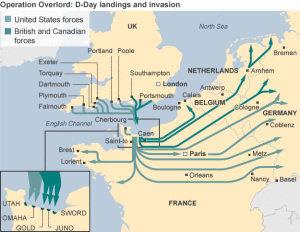What was D-Day?
On 6 June 1944, British, US and Canadian forces invaded the coast of northern France in Normandy.
The landings were the first stage of Operation Overlord – the invasion of Nazi-occupied Europe – and were intended to end World War Two.
Portsmouth’s D-Day Museum says as many as 4,413 Allied troops died on the day of the invasion – more than previously thought.
By the end of D-Day, the Allies had established a foothold in France. Within 11 months Nazi Germany was defeated, as Soviet armies swept in from the east and captured Hitler’s stronghold in Berlin.

The Allies failed to achieve all of their goals on the first day. Carentan, St. Lô, and Bayeux remained in German hands, and Caen, a major objective, was not captured until 21 July. Only two of the beaches (Juno and Gold) were linked on the first day, and all five bridgeheads were not connected until 12 June. However, the operation gained a foothold that the Allies gradually expanded over the coming months. German casualties on D-Day were around 1,000 men. Allied casualties were at least 12,000, with 4,413 confirmed dead. Museums, memorials, and war cemeteries in the area host many visitors each year.






0 comments
Add your comment